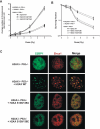H2AX haploinsufficiency modifies genomic stability and tumor susceptibility
- PMID: 12914701
- PMCID: PMC4737479
- DOI: 10.1016/s0092-8674(03)00567-1
H2AX haploinsufficiency modifies genomic stability and tumor susceptibility
Abstract
Histone H2AX becomes phosphorylated in chromatin domains flanking sites of DNA double-strand breakage associated with gamma-irradiation, meiotic recombination, DNA replication, and antigen receptor rearrangements. Here, we show that loss of a single H2AX allele compromises genomic integrity and enhances the susceptibility to cancer in the absence of p53. In comparison with heterozygotes, tumors arise earlier in the H2AX homozygous null background, and H2AX(-/-) p53(-/-) lymphomas harbor an increased frequency of clonal nonreciprocal translocations and amplifications. These include complex rearrangements that juxtapose the c-myc oncogene to antigen receptor loci. Restoration of the H2AX null allele with wild-type H2AX restores genomic stability and radiation resistance, but this effect is abolished by substitution of the conserved serine phosphorylation sites in H2AX with alanine or glutamic acid residues. Our results establish H2AX as genomic caretaker that requires the function of both gene alleles for optimal protection against tumorigenesis.
Figures






Similar articles
-
Functional interaction of H2AX, NBS1, and p53 in ATM-dependent DNA damage responses and tumor suppression.Mol Cell Biol. 2005 Jan;25(2):661-70. doi: 10.1128/MCB.25.2.661-670.2005. Mol Cell Biol. 2005. PMID: 15632067 Free PMC article.
-
Histone H2AX: a dosage-dependent suppressor of oncogenic translocations and tumors.Cell. 2003 Aug 8;114(3):359-70. doi: 10.1016/s0092-8674(03)00566-x. Cell. 2003. PMID: 12914700
-
Aberrant V(D)J recombination is not required for rapid development of H2ax/p53-deficient thymic lymphomas with clonal translocations.Blood. 2008 Feb 15;111(4):2163-9. doi: 10.1182/blood-2007-08-104760. Epub 2007 Sep 13. Blood. 2008. PMID: 17855626 Free PMC article.
-
H2AX may function as an anchor to hold broken chromosomal DNA ends in close proximity.Cell Cycle. 2004 Feb;3(2):149-53. doi: 10.4161/cc.3.2.689. Cell Cycle. 2004. PMID: 14712078 Review.
-
Characteristics of gamma-H2AX foci at DNA double-strand breaks sites.Biochem Cell Biol. 2003 Jun;81(3):123-9. doi: 10.1139/o03-042. Biochem Cell Biol. 2003. PMID: 12897845 Review.
Cited by
-
Highly sensitive automated method for DNA damage assessment: gamma-H2AX foci counting and cell cycle sorting.Int J Mol Sci. 2013 Jul 30;14(8):15810-26. doi: 10.3390/ijms140815810. Int J Mol Sci. 2013. PMID: 23903043 Free PMC article.
-
Cellular context-dependent effects of H2ax and p53 deletion on the development of thymic lymphoma.Blood. 2011 Jan 6;117(1):175-85. doi: 10.1182/blood-2010-03-273045. Epub 2010 Oct 14. Blood. 2011. PMID: 20947684 Free PMC article.
-
Dissection of the unusual structural and functional properties of the variant H2A.Bbd nucleosome.EMBO J. 2006 Sep 20;25(18):4234-44. doi: 10.1038/sj.emboj.7601310. Epub 2006 Sep 7. EMBO J. 2006. PMID: 16957777 Free PMC article.
-
Functional interaction of H2AX, NBS1, and p53 in ATM-dependent DNA damage responses and tumor suppression.Mol Cell Biol. 2005 Jan;25(2):661-70. doi: 10.1128/MCB.25.2.661-670.2005. Mol Cell Biol. 2005. PMID: 15632067 Free PMC article.
-
Bisbenzamidine derivative, pentamidine represses DNA damage response through inhibition of histone H2A acetylation.Mol Cancer. 2010 Feb 9;9:34. doi: 10.1186/1476-4598-9-34. Mol Cancer. 2010. PMID: 20144237 Free PMC article.
References
-
- Agrawal A, Schatz DG. RAG1 and RAG2 form a stable postcleavage synaptic complex with DNA containing signal ends in V(D)J recombination. Cell. 1997;89:43–53. - PubMed
-
- Barlow C, Hirotsune S, Paylor R, Liyanage M, Eckhaus M, Collins F, Shiloh Y, Crawley JN, Ried T, Tagle D, Wynshaw-Boris A. Atm-deficient mice: a paradigm of ataxia telangiectasia. Cell. 1996;86:159–171. - PubMed
MeSH terms
Substances
Grants and funding
LinkOut - more resources
Full Text Sources
Other Literature Sources
Molecular Biology Databases
Research Materials
Miscellaneous

